How to Get Rid of Old Gasoline (USA Guide)
Dealing with old gasoline isn’t just about making space in your garage — it’s about protecting your health, your equipment, and the environment. Many people don’t realize that stale gasoline can become dangerous over time. It breaks down due to gasoline oxidation, becoming less effective and even harmful to engines. Pouring it down the drain or tossing it in the trash isn’t just unsafe — it’s illegal.
Whether you’re handling a few ounces or several gallons, knowing how to dispose of old gasoline safely is critical. This guide will walk you through every step, from safe gasoline storage to final disposal at a state hazardous waste facility near you.
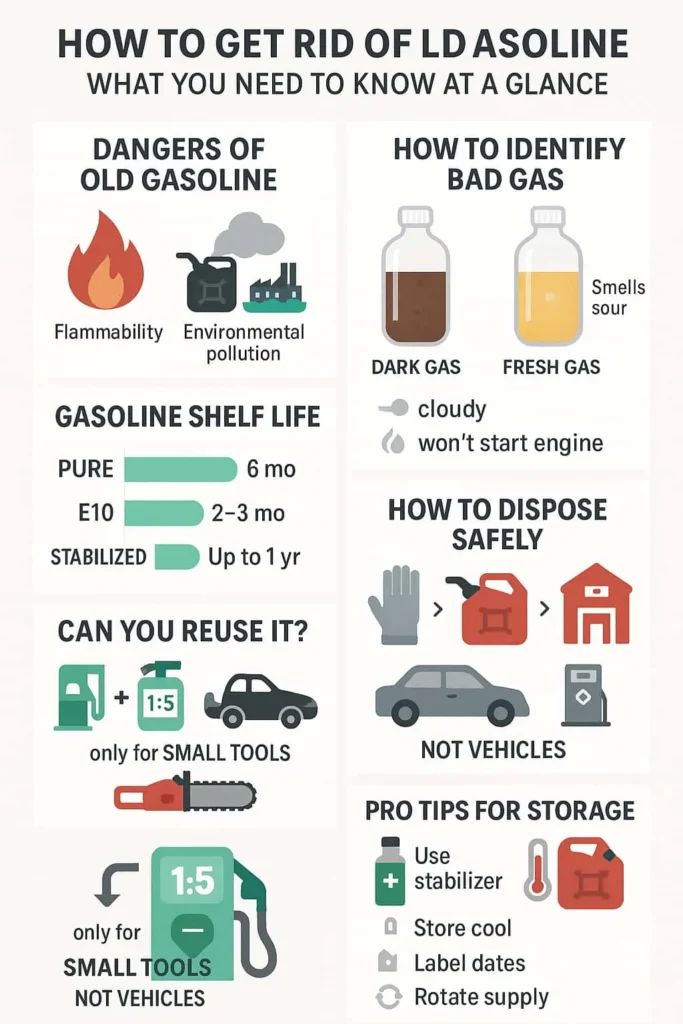
Why You Should Never Throw Old Gasoline in the Trash
You can’t just pour gasoline into your trash can. That’s dangerous and illegal. Gasoline evaporates easily, releasing harmful vapors into your home or garage. It can catch fire from a single spark. Even worse, can you pour gas on the ground? Absolutely not. It can seep into the soil and contaminate your water.
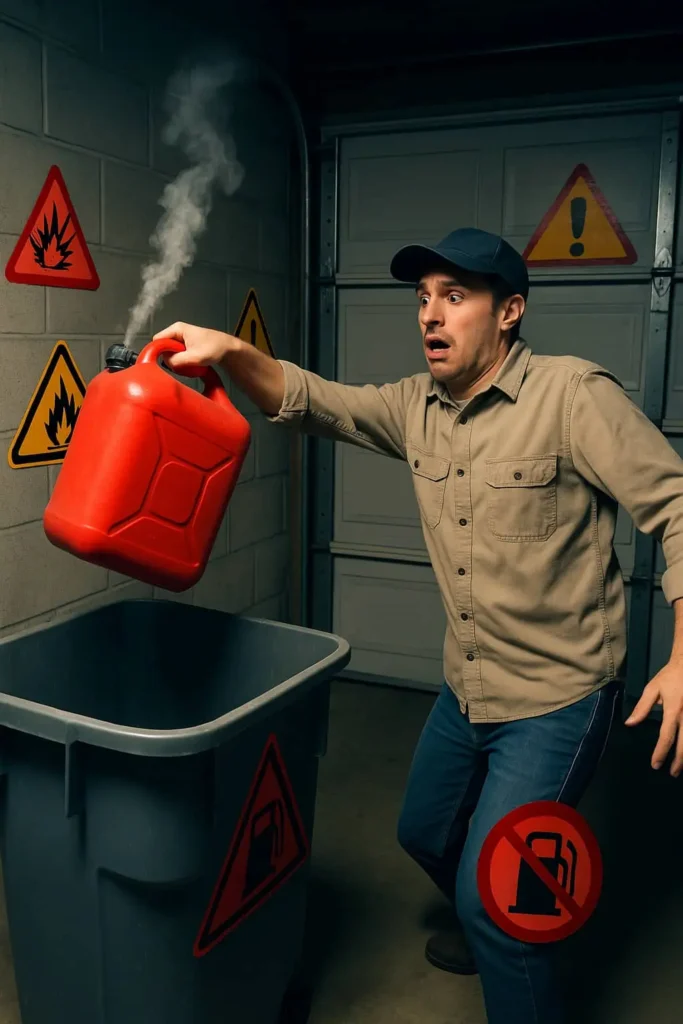
Environmental risks of gasoline are serious. The EPA lists it as household hazardous waste. That means it’s regulated. There are legal ways to dispose of gas, and they vary by state. Breaking those rules can lead to fines. That’s why you should always check with your state hazardous waste facility or local waste management.How to Identify If Gasoline Is Bad or Still Usable
Knowing how to tell if gasoline is bad starts with your senses. Old gas often smells sour, and it looks darker than fresh fuel. It may even look cloudy or have particles floating in it. That means you’re dealing with contaminated gasoline.
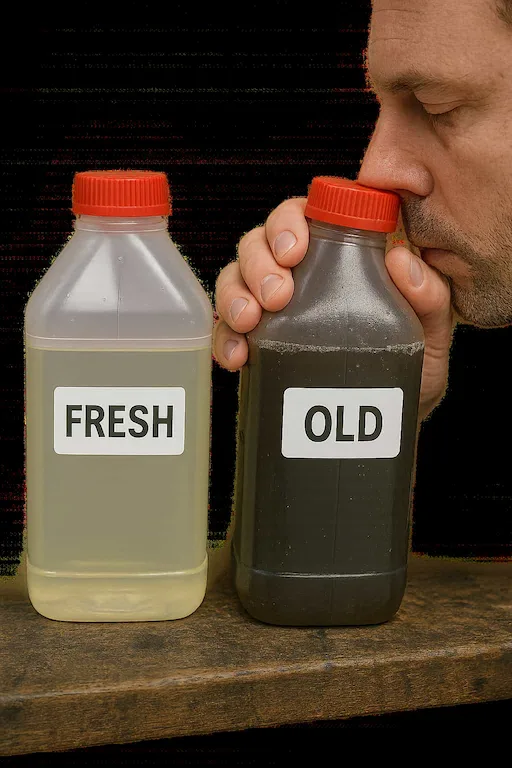
When gasoline degradation begins, it loses volatility. Engines won’t start, or they might stall. That’s called small engine surging. This is a common issue in mowers, trimmers, or generators that have been sitting all winter. If you’re not sure, mix a small amount with new gas and test it on old equipment. But remember, is it safe to mix old and new gas? Only in small amounts, and never in high-end engines.
How Long Does Gasoline Last?
So, how long does gasoline last? Fresh gasoline lasts about three to six months if stored properly. But fuel with ethanol in gasoline has a shorter life. Ethanol pulls in moisture, which causes fuel contamination much faster. That means E10 gasoline can become useless in as little as 30 to 90 days.
Take a look at this simple table:
| Type of Gasoline | Expected Shelf Life |
| Pure gasoline | 6 months |
| E10 (10% ethanol) | 2 to 3 months |
| Stabilized gasoline | Up to 1 year |
A fuel stabilizer can help extend that time. So if you want your fuel to last, consider using one.
Safe Storage Before Disposal
Before you get rid of it, you need safe gasoline storage. Always store it in approved gasoline containers. Keep them in a cool, dry place—away from direct sun or heat. Never store them indoors or near a flame.
Proper containers reduce the risk of leaks and gasoline and engine damage. Follow the label instructions and make sure the cap is tight. If your container is damaged or old, ask how to dispose of gasoline cans? Your local hazardous site will know.
Step-by-Step Guide to Properly Dispose of Old Gasoline
How to dispose of old gasoline safely starts with locating a nearby drop-off. Find a fuel disposal service near me by contacting your local waste management or fire department. They’ll guide you to a hazardous waste disposal site.
Here are the basic steps:
- Wear gloves and work in a well-ventilated area.
- Pour gas into a clean, clearly labeled approved container.
- Drive it to the site following gasoline disposal laws.
Most household hazardous waste centers accept gas for free, especially during community clean-up events.
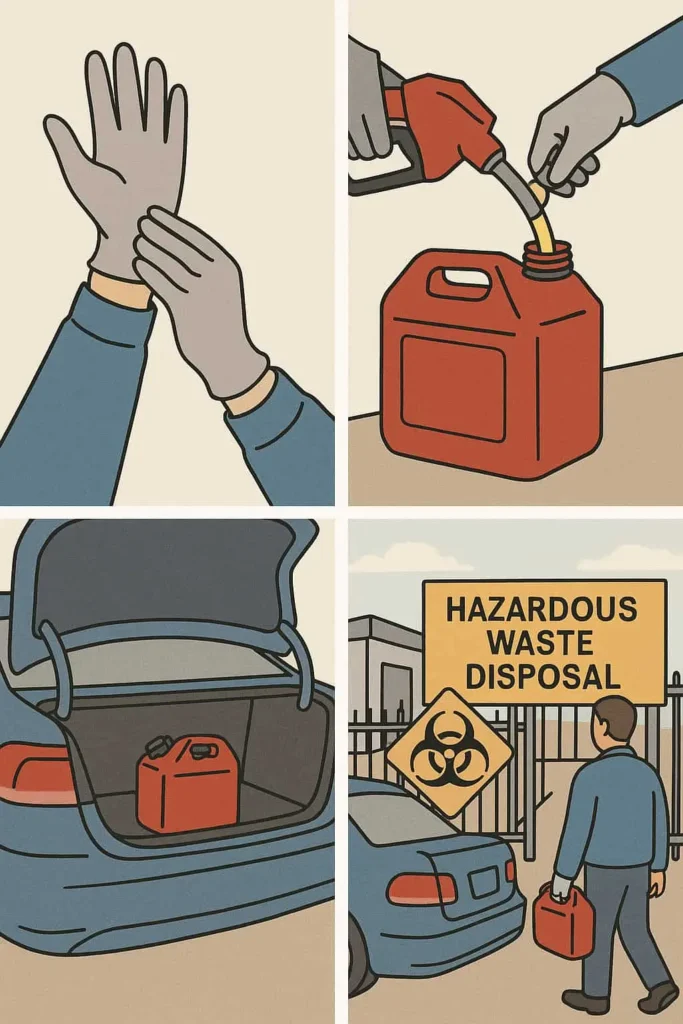
Can Old Gasoline Be Recycled or Reused?
You may wonder, can old gasoline be recycled or reused? Yes, but with caution. Professionals can handle gasoline recycling safely. For homeowners, you can recondition old gas by filtering it and mixing it with fresh fuel. But again, only in older tools. Don’t risk it in vehicles or high-performance machines.
Mix it at a 1:5 ratio. That means one part old gas to five parts new. Then add a fuel stabilizer. Still, if it smells terrible or looks muddy, just dispose of it.
Transporting Gasoline Safely for Disposal
Transporting flammable liquids like gasoline needs care. Always use DOT-approved gasoline containers. Don’t put them inside your car’s passenger cabin. If you don’t have a truck, keep them in your trunk with the windows down.
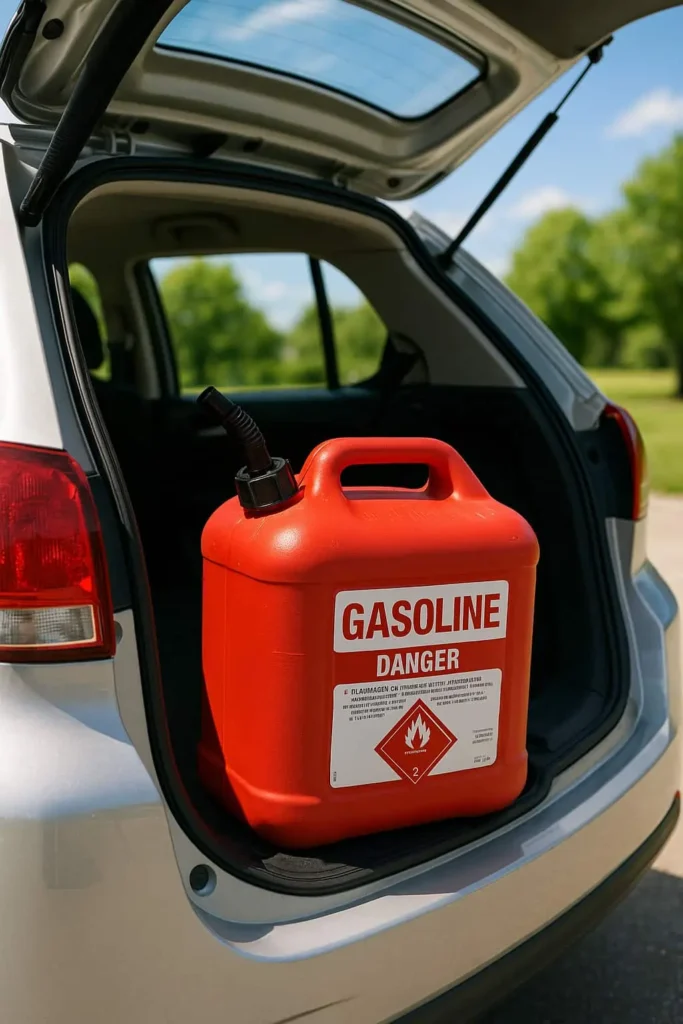
Businesses must follow FMCSA regulations. That includes using proper placards and having insurance. For most people, just make sure the can is sealed, upright, and away from heat. Transporting gasoline legally is key for everyone’s safety.
What to Do If Gasoline Spills
Gasoline spills can be dangerous. First, ventilate the area. Don’t turn on lights or devices that could spark. If it’s a small spill, soak it up with sand, kitty litter, or rags. Then seal the waste in a fire-safe container.
Call your local fire department for large spills. You may need to report it, depending on your state. Never hose it into a drain or dirt. It’s a violation of gasoline storage regulations and environmental laws.
How Specific Waste Services Can Help
Sometimes, it’s better to leave things to professionals. Companies that handle hazardous waste disposal have the right gear and licenses. They know where to dispose of stale gasoline and follow all local, state, and federal rules.
Whether you’re a homeowner or business, they offer pickup, storage, and proper disposal of gas cans too. Call ahead, describe your quantity, and ask about any fees.
Pro Tips to Make Gasoline Last Longer
Want to avoid dealing with bad gas again? Here’s how. Store fuel in a cool place. Use only air-tight containers. Add a fuel stabilizer as soon as you buy it. This prevents gasoline oxidation and extends shelf life.
Also, rotate your supply. Use older gas first. Keep containers labeled with dates. This helps you know when to dispose of or reuse. These simple habits prevent gasoline degradation and save money.
Faqs about How to Get Rid of Old Gasoline
1. What’s the safest way to dispose of old gasoline?
Old gasoline should be taken to a household hazardous waste (HHW) facility, a local waste collection event, or sometimes a fire station or auto repair shop. Always store and transport it in approved gasoline containers—upright, sealed, and away from heat sources. Never pour it on the ground, into drains, or throw it in the trash.
2. Can old gasoline be treated or reused?
Yes, but only for non-essential equipment like lawnmowers or generators. Filter it and remove any water, then mix it with fresh fuel—usually in a 1:5 (old to new) ratio. Avoid using it in vehicles or high-performance engines, especially if the fuel smells sour or shows signs of separation.
3. How should I remove water from gas?
Let the gas sit in a clear container until water settles at the bottom, then carefully pour off the clean gas. For small amounts of moisture, isopropyl alcohol can help absorb it.
4. How long does gasoline stay usable?
Gasoline typically lasts 3–6 months. Ethanol-blended fuels may degrade even faster. Using a fuel stabilizer can extend its life up to a year, especially when stored in airtight containers.
5. Does gasoline go bad in plastic containers?
Yes, particularly if the container isn’t airtight. Gasoline exposed to air degrades faster. For better storage, use metal or certified plastic containers that seal tightly and keep them in a cool, dry place.
6. What are fuel stabilizers, and should I use them?
Fuel stabilizers are additives that prevent gasoline from oxidizing and breaking down. They’re especially useful if you store gas for long periods. Add them to fresh gas and run the engine briefly to circulate the treatment.
7. How do I mix old & new gas—any special technique?
Shake the container gently or rock the equipment to ensure the old and new fuel mix evenly. You can also add a fuel-line antifreeze product to help with any remaining moisture.
8. Can I pour old gas on the ground or burn it?
No. Burning or dumping gasoline is unsafe and harmful to the environment. Always dispose of it through proper channels.
9. Who accepts old gasoline?
Disposal options include HHW facilities, community collection events, fire departments, auto repair shops, and sometimes local waste transfer stations. Always call ahead to confirm they accept gasoline.
Final Thoughts: Knowing how to get rid of old gasoline the right way helps you protect your tools, your family, and the environment. The key is to act early, follow safety steps, and never cut corners. When in doubt, ask your state hazardous waste facility or trusted fuel disposal services near me. They’re there to help.
If you found this guide helpful, share it with your crew or neighbors. Chances are, they have a rusty gas can sitting around too. Let’s get rid of it safely—together.







